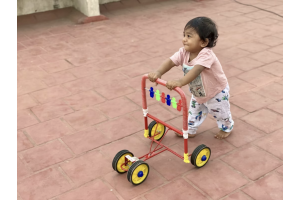How STEM Education Benefits Young Children

Starting certain elements of education early can help give kids a great start in life. This isn’t just from the perspective of setting them up for academic prospects and careers. It also gives them the tools they need to explore the world around them and follow their curiosity.
From this perspective, it’s important to give children a well-rounded experience in their early education years. There is increasing recognition of the importance of science, technology, engineering, and math (STEM) for young children. Historically, these subjects were considered too advanced for young learners. But there are in fact a range of advantageous skills and ideas STEM fields can offer students of any age.
What Is STEM Education?
On the surface, STEM education is the formal teaching of science, technology, engineering, and math subjects. Though many teachers and homeschooling parents teach these topics separately, there is also significant crossover. From an early years perspective, the latter is particularly important. This is because teaching the individual theoretical subjects can be overwhelming and off-putting for some learners.
As such, STEM education for younger children is generally best pursued from a project perspective. Teachers and parents alike can help children address their needs through the use of STEM. As kids engage in the fun and practical elements of the project, they can also be taught aspects of the underlying theoretical concepts involved.
Indeed, it is increasingly practical and accessible to make STEM education a part of children’s play. Younger kids can play with game coding software that introduces them to information technology practices. Not to mention there are a variety of open-source electronic prototyping kits. These tools — Arduino and Raspberry Pi among them — encourage technological exploration and understanding.
Cultural Relevance
STEM education for younger students is particularly relevant from a cultural perspective. These children are among the first generations of digital natives. They have never lived in a world without advanced technological tools. As such, the majority of their experiences will be impacted by their relationships with tech. In many ways, a solid STEM education qualifies as basic key skills for all children, as it helps them to navigate the 21st century.
Starting a STEM journey early on plays a crucial role in kids’ development process. The hands-on technological experiences help them become more confident with the tools of the digital age. A well-rounded STEM curriculum also promotes the importance of collaboration. They learn to recognize one another’s talents to innovate in these fields. Perhaps most importantly, a focus on STEM concepts prevents children from getting left behind in a school system and culture that demands these skills.
With this solid early understanding of — and enthusiasm for — STEM, young kids have a foundation to build upon as they grow. Technology will only get more advanced and complex in the years and decades ahead. This generation will be emerging into a workforce that operates alongside artificial intelligence, data analytics, and augmented reality as part of their basic duties. Early engagement prepares them not just to function post-graduation, but to apply their curiosity and knowledge to innovate.
Problem-Solving Skills
While STEM subjects may have a theoretical basis, at their core they are tools for solving problems. They’re about using observable facts about the universe to devise a practical way to achieve a goal. Introducing kids to these processes from an early age is beneficial to various areas of their lives. You’re giving them the tools to carefully and intelligently navigate the hurdles they’ll be faced with.
You can begin by showing how STEM pioneers have solved relatable problems in the world around them. Give them books about the development of communications devices. Show movies and documentaries about the evolution of the internet. But inspire them, too. Talk about how STEM helped humans get into space.
You can then get them practically engaged with the methods of STEM problem-solving. Set a problem to solve. It can be as simple as a new way to carry groceries or as important as the challenges of climate change. Brainstorming can make the ideation process more exciting, but you should be sure to keep this structured. Set an agenda and make sure everyone is clear on the goals. This provides kids with good techniques to collaborate in STEM subjects and other areas of their education.
Diversity Boost
Perhaps one of the most important roles STEM plays is in boosting inclusivity. A lack of diversity is a serious problem across all STEM fields. Part of the issue is how STEM is presented during childhood. There has been a historical tendency for kids to be discouraged because they don’t see people like themselves in engineering. They may also feel they don’t quite fit the scientific stereotypes presented to them.
Help kids to understand STEM is for them no matter what their background is. Representation is an important tool in empowering children to engage with these subjects. Introduce them to diverse role models who have provided valuable contributions in STEM fields. Celebrate the achievements of minority STEM professionals. Include innovators across the gender, racial, socioeconomic, neurodivergent, and mobility spectrum.
Attend to diversity throughout your STEM projects. Make sure each group of kids comprises a varied range of students. Importantly, be cognizant of avoiding stereotypes when you’re assigning roles, especially leadership positions. Make sure all students have an opportunity to contribute meaningfully. Reinforce the fact that all ideas and perspectives are valuable in STEM.
Creative Thought
STEM subjects are often at the forefront of innovation. This isn’t necessarily because complex theories and well-educated professionals are involved. Rather, it’s because excelling in these fields and making new discoveries requires the application of a rich imagination. You can’t innovate unless you can think of something that doesn’t yet exist. As such, one of the benefits of early STEM education is its ability to boost kids’ creative thinking skills.
Talk to kids about how fiction has often led to innovations in STEM fields. You can use examples like Star Trek’s automatic door systems or Jules Verne’s depiction of the submarine. This helps to show them even their most unusual and creative ideas could influence the practical future of the world. This in turn can spur their curiosity and give them the confidence to ideate in STEM areas.
You can also show how STEM is a tool to drive creativity. Demonstrate the scientific and technological concepts that make musical instruments work. Bring various musical instruments into class so they can get a hands-on sense of how the STEM theory and practical application combine to make something fun. Start projects where they make their own rudimentary musical instruments from random materials by applying their scientific and creative knowledge.
Conclusion
Introducing STEM subjects to children at a young age provides them with key skills and experiences. They can gain a practical understanding of culturally relevant tools and boost their creative and problem-solving abilities. Learning an enthusiasm for STEM early can also positively impact how kids from diverse backgrounds engage with the subjects. STEM unlocks so much of the world for children, it is our duty to give them the keys as soon as possible.






